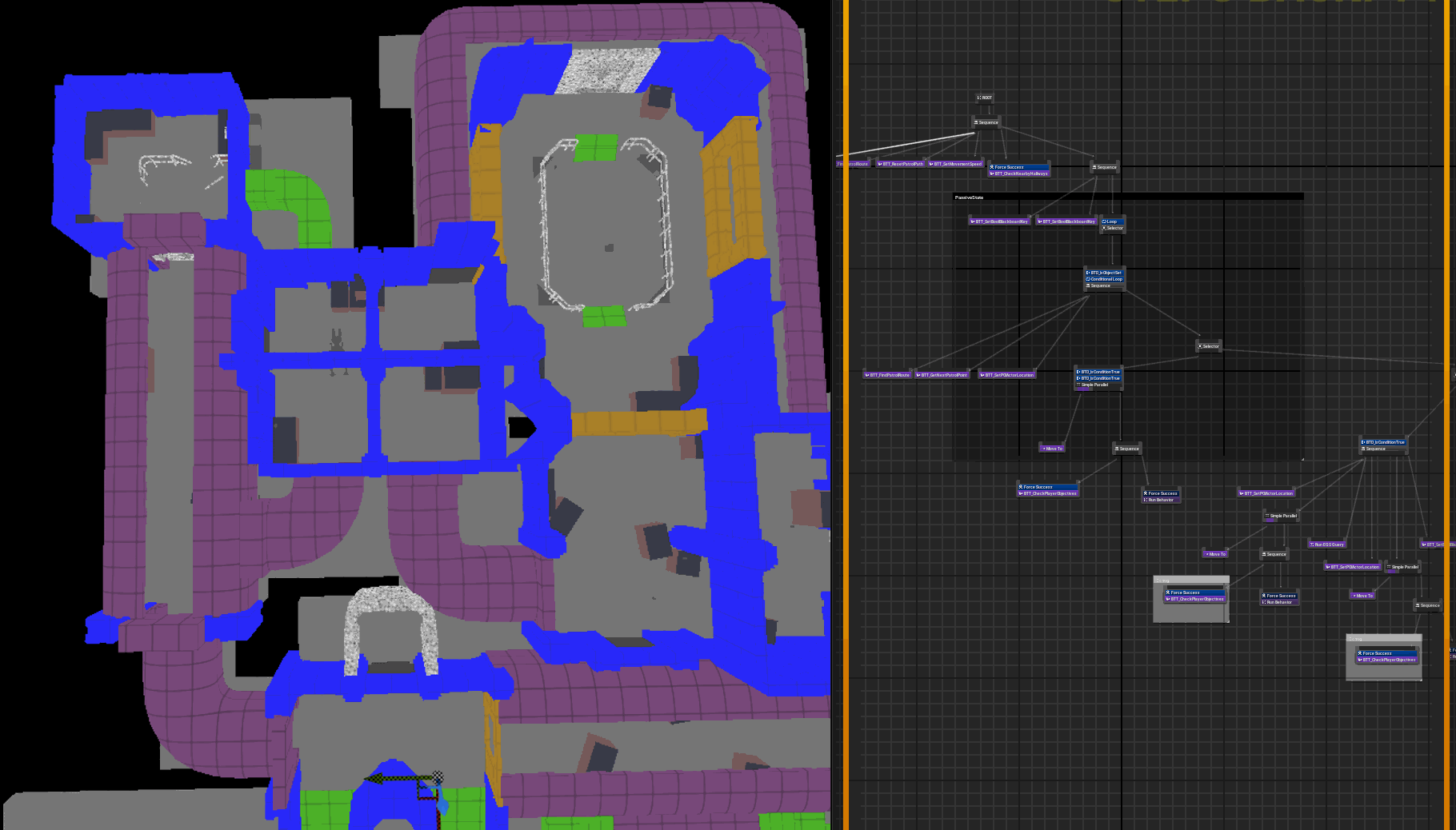

SOUNDS OF SHADOWS
01
Sounds of shadows is a first-person horror survival game, where you play as a blind robot, using echolocation to reveal the environment through sounds. Be careful to not be too loud however, or the monster will find you.

Team of 24
UE5

ABOUT
Project responsibilities
-
Delivering 3 entire levels
-
Iterate on level blockout
-
Designing scripted encounters
-
Set dressing
-
Creating and maintaining documentation
-
Coordinating interdisciplinary development
-
Ideated and prototyped core game concept
02
Sounds of Shadows is a survival horror game taking place in a broken down underground science facility. Play as a blind maintenance robot and use echolocation to navigate the environment. Sounds help you see, but might attract the monster lurking in the shadows.
Overview





The game is comprised of three levels, first to introduce the narrative, mechanics and monster, second to develop the gameplay loop, and last to conclude narrative.
03
Design challenges
This project had significant level design challenges, especially orienting and leashing the player through the dark environments. Players needed to create a mental map of the level despite the limited visibility, the level design needed to help players not get lost.
Here's how the level tackles this issue:
Sectioning
To help players make mental maps, the level utilizes tricks to clearly section part of the level. Such as elevation, one-way passages, corridors with doors to separate two areas...

Visual Identity
In addition to sectioning the level, it was important to have each room/section have a clear visual identity, in its shape, ceiling height, purpose...etc. This would help players immediately know if they had been there previously and create a sense of progression.

Landmarks
Through playtesting I found that players often orient themselves in relation to a reference point. I found that having a specific landmark visible at all times in larger rooms greatly helped players get their bearings.

Leashing
Guiding the player in a non-invasive way was instrumental in ensuring they find their way to the objectives. Using things like color, sounds, bread crumbing... etc

04
A level for a monster
The levels needed to be designed for the monster, as much as they were designed for the player. As the AI was being developed in parallel to the levels, we soon realized that there needed to be a constant communication between those two aspects of the game to create a coherent player experience.
The monster is a central part of our game, and as such, I learnt it was important that my levels supported and worked hand-in-hand with the monster AI.
Levels went through a lot of iterations, as the enemy behavior was being polished by our AI designer, it was important for me to find ways to create a level that would take advantage of that behavior, and would promote all these organic player-monster interactions.
This was done through the creation of tightly interconnected levels, allowing the monster to flank, roam, and surprise the players. Tweaking the objective locations, in relation to the "risk areas" where the monster roamed, was also key in controlling the pacing of the overall level.


Metrics
Establishing clear metrics early on was critical, to ensure the enemy AI could easily navigate the level, and create a degree of consistency across the levels.
These metrics were also used to inform 3D artists in creating modular level kits (see below).

Working with artists
05

A bridge between environment art and level design needed to be maintained to allow for a constant communication. After establishing clear metrics for the levels, artists were able to create a modular kit for me to build the levels.
Set dressing for the level was interesting, the limited visibility in-game gave us the opportunity to spend less time on details, and instead focus in creating visually interesting environments to support the echolocation mechanic.




Vents are safe spaces for the player to hide, allowing to release tension and create moments of respite.
Turn sound on for a better experience !
Building tension during the parkour section using environmental sound triggers.
Turn sound on for a better experience !
The introduction of the monster is a key gameplay beat. Here it is done from a safe space using a scripted event.
Turn sound on for a better experience !
Monster ambush scripted sequence.
Catching the player off guard during a "safe" moment.
06
Managing tension
Tension is a crucial element of any horror game, and properly building it, maintaining it and releasing it is a key component to a good level. The use of scripted sequences, pacing and space used properly can create a great horror experience.




07
Retrospective
This was my first time working in such a large team, I quickly realized how central the role of level designer is. A lot of my time during this project was spent coordinating and discussing with other specializations. Communication was really one of the strong points of this project, collaboration was fluid and efficient. Working so closely with AI designers especially, I have learnt the importance of understanding not only the player behaviors, but also the AI behaviors. Levels must be designed for both, not only for players.
I've enjoyed having to delve deeper into player psychology to understand how to help them orient themselves, finding tricks players use unconsciously to help them find their way through the dark level. But sometimes it could also be frustrating to watch playtesters get completely lost in your level!
Lastly, this project taught me a lot about scope. Delivering three levels was too ambitious, which ended up decreasing their overall quality, and put more stress than necessary on the team. In the future it would be better to start with a low scope, and expand it later if we have the ressources.


